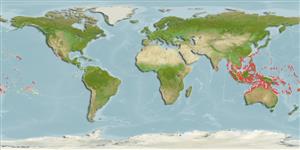>
Eupercaria/misc (Various families in series Eupercaria) >
Labridae (Wrasses) > Corinae
Etymology: Macropharyngodon: Greek, makros = great + Greek, pharyngx = pharynx + Greek,odous = teeth (Ref. 45335).
More on author: Herre.
Environment: milieu / climate zone / depth range / distribution range
Sinh thái học
Biển Cùng sống ở rạn san hô; không di cư; Mức độ sâu 8 - 32 m (Ref. 1602), usually 8 - 32 m (Ref. 27115). Tropical; 24°C - 28°C (Ref. 27115); 30°N - 24°S
Eastern Indian Ocean and Western Pacific: Andaman Sea (Ref. 9710) and Christmas Island (Ref. 30874) to the Philippines and Samoa, north to Ryukyu Islands, south to northern Australia.
Bộ gần gũi / Khối lượng (Trọng lượng) / Age
Maturity: Lm ? range ? - ? cm
Max length : 12.0 cm TL con đực/không giới tính; (Ref. 9710)
Các tia vây lưng cứng (tổng cộng) : 9; Các vây lưng mềm (tổng cộng) : 11; Tia cứng vây hậu môn: 3; Tia mềm vây hậu môn: 11; Động vật có xương sống: 25. Color in life of black with iridescent blue-green spots on body and light yellow antero-dorsally on head body; head banded. Anterior lateral line pored scales 2-3. Males display with metallic green shiny color that is turned on shortly for the occasion (Ref. 48636).
Inhabits lagoon and seaward reefs, in areas of mixed sand and coral (Ref. 9710). Post pelagic juveniles carried by currents beyond their normal breeding range. They are often in pairs or small loose groups, swimming close to the bottom. When approached, they move up and down in an unusual way that may worry a possible predator. Adults move about in small groups. (Ref. 48636).
Life cycle and mating behavior
Maturities | Sự tái sinh sản | Spawnings | Egg(s) | Fecundities | Ấu trùng
Oviparous, distinct pairing during breeding (Ref. 205).
Randall, J.E., 1978. A revision of the Indo-Pacific labrid fish genus Macropharyngodon, with descriptions of five new species. Bull. Mar. Sci. 28(4):742-770. (Ref. 2694)
IUCN Red List Status (Ref. 130435)
Threat to humans
Harmless
Human uses
Các nghề cá: Tính thương mại; Bể nuôi cá: Tính thương mại
Các công cụ
Special reports
Download XML
Các nguồn internet
Estimates based on models
Preferred temperature (Ref.
123201): 25.2 - 29, mean 28.1 °C (based on 866 cells).
Phylogenetic diversity index (Ref.
82804): PD
50 = 0.5002 [Uniqueness, from 0.5 = low to 2.0 = high].
Bayesian length-weight: a=0.00977 (0.00470 - 0.02030), b=3.07 (2.89 - 3.25), in cm total length, based on LWR estimates for this (Sub)family-body shape (Ref.
93245).
Mức dinh dưỡng (Ref.
69278): 3.5 ±0.4 se; based on size and trophs of closest relatives
Thích nghi nhanh (Ref.
120179): Chiêù cao, thời gian nhân đôi của chủng quần tối thiểu là dưới 15 tháng (Preliminary K or Fecundity.).
Fishing Vulnerability (Ref.
59153): Low vulnerability (10 of 100).
Nutrients (Ref.
124155): Calcium = 99.8 [59.3, 177.4] mg/100g; Iron = 0.773 [0.445, 1.445] mg/100g; Protein = 18.5 [15.6, 20.7] %; Omega3 = 0.17 [0.11, 0.28] g/100g; Selenium = 22.8 [13.0, 42.4] μg/100g; VitaminA = 158 [48, 611] μg/100g; Zinc = 1.75 [1.17, 2.72] mg/100g (wet weight);
